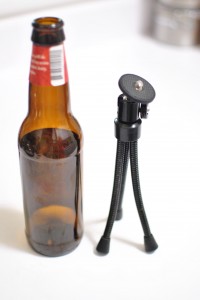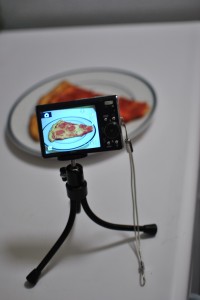Grant Achatz, the chef at Alinea (where Josh and I had the best meal of our lives), recently wrote a post on the restaurant’s message board regarding bloggers taking photos of their food and how it was ruining the integrity of the food and affecting the enjoyment of the meal. When I first read an excerpt of the post on Eater, in which Chef Achatz mentions a blogger taking pictures with a camera resting on a tripod, my heart started racing. “Holy crap!” I thought, “Could he be talking about me?”
Then I read further, discovering that the incident occurred a month ago, and the course described was the famous “hot potato/cold potato” dish. I breathed a sigh of relief, as that was not one of the dishes we had when we ate at Alinea, and we were there almost a year ago, not a month ago. But even so, his outrage could still be aimed at me, as I was a blogger at the time of our meal, and yes, I did use a tripod to photograph the dishes we had.
Before people start getting worked up about the use of a tripod in a restaurant, please let me explain further. We’re not talking about a gigantic tripod that needs to be set up on the ground, or a huge tabletop tripod that supports the largest of cameras. We’re not even talking about those wacky looking Gorillapods. My tripod is a “jr. flex” that maxes out at 6.5 inches in height and weighs less than 4 ounces. The legs are bendable and there is a mini ball head so that I can easily tilt the angle of my small point and shoot camera.
The tripod screws directly into my camera, and I leave it like that for the duration of any meal. That way I don’t disrupt anyone with constantly having to screw in and unscrew the tripod. The combination of the tripod and the camera is still small enough that I keep them both on my lap, under my napkin, while we’re eating each course. The only time I whip out the camera is when I see that our dishes are about to be served. I’ll turn the camera on discreetly while it’s still on my lap, and set the auto timer for 3 seconds. The flash is always turned off.
When the dish is placed in front of me, usually I’ll just bring the camera up from my lap, rest two legs of the tripod on the edge of the table directly in front of me, quickly frame the shot, and press the shutter button. The timer ticks down 3 seconds, and the camera will take a picture. My body and the angle of my arms helps to obscure the fact that I’m taking a photo, so I don’t believe that I’m disrupting diners at other tables.
I started using the tripod because I was having a hard time taking pictures in dark restaurants, and I could never hold my hands steady enough to take a good shot. As a result, I would have to retake photos again and again until I got one that worked. The tripod solved almost all of my issues, as it provided a support against my shaky hands, and now it takes me less than 30 seconds to frame a shot and take a decent picture (or two).
I will admit that at Alinea, there were some courses that required me to rest the tripod fully on the table due to the size or shape of the serving dish. But again, we’re talking about a tiny black tripod that when the legs are spread out to balance the camera, it’s only about 4 inches off the table. As soon as I saw the servers coming over with each course, I had my camera on and ready to go. I only needed to set the camera down, angle the shot, and press the button. All of this would be done while the server was describing the course.
Because it was Alinea though, I did take about 2 or 3 additional shots of each dish from slightly different angles (using a rest on two legs and click method). Each presentation was just so complex that I wanted to make sure that I fully captured the beauty. Still, it was all done quickly while the server was still talking, because I was as eager as everyone else to dive into the dish. Had I been told to eat a dish right away, I would have already taken my three second shot by the time I was instructed to do so, and I would have popped whatever it was into my mouth.
Was it a bit hectic for me to make sure I got all my shots in? Yes. But do I feel like it took away from my dining experience? No. We were all just so excited to eat this meal, and I was excited to have photographs of each course that I could share with my friends afterward. It was one thing for me to describe sucking down bubble gum tapioca from a test tube, it was much more effective to be able to show a picture of said test tube.
We did get to visit the kitchen at Alinea, and I took a few still photos of Chef Achatz and some of the other personnel, but not before I asked permission to do so. It never even occurred to me to take video, and that’s not something that I would do.
I think bloggers are getting a lot of flack lately because there are so many of us out there. More times than not, there’s usually someone else in a restaurant taking photos besides me. Whether it’s for their own enjoyment, or if they indeed are bloggers, I don’t know, but I think people pretty much assume now that anyone taking photos is a blogger.
As I’m relatively new the blogosphere, I don’t know what it was like when bloggers were unique creatures that spread the word about their favorite restaurants and provided free advertisement and endorsements for those restaurants. Chef Achatz does credit these people for encouraging awareness of food and dining, and for helping Alinea increase its popularity. However, I do feel that right now, there’s a lot of backlash against bloggers in regards to photo taking, or critical reviews based on one experience, etc. All of this is starting to make me feel extremely self-conscious when I’m eating a meal that I plan to post about, so I do try harder to take photos and notes more discreetly. We have since graduated to an SLR with a special lens designed for taking photos in low light environments, and I’ve had to adjust to using a larger, more conspicuous camera but I’m still trying to be unobtrusive about it.
With regards to our experience at Alinea, I don’t believe that my photo taking using my mini tripod was disruptive to other diners, both at our table and at surrounding tables. The other tables were spread pretty far apart but it was quiet enough to hear snatches of conversations, and as far as I know, no one made a comment about my photography. As for the other diners in our party, I was surrounded by people who loved food, loved the experience, and was just as eager as I was to share our account with others.
If I had been asked to stop taking pictures, or told that it was against the restaurant’s policy, I might have been annoyed but I would have immediately desisted. Josh and I generally don’t even photograph other people’s food, only our own, unless we’re specifically requested to do so by the person who ordered the dish. That way everyone else can start eating right away and we won’t disturb them when we stop to take a photo. I’m not trying to ruin anyone’s experience, nor am I taking photos just for the sake of taking them. I honestly enjoy going through all my old food photos and reminiscing about some of the meals we’ve had. If you think I have lots of pictures of food on this blog, you haven’t seen my personal Picasa albums! And the vast majority of the food photos posted there were taken well before this blog existed, back when I was just a tourist who loved to eat.
If Josh and I were rich or famous and could eat out at amazing places every night, maybe there would be less of a novelty for us to document most of our meals. Unfortunately, we’re not, so most of these meals are pretty special occasions for us and we want to remember them and be able to tell our friends about them. In addition to being the best meal that we’ve ever had, Alinea was also by far the most expensive meal we’ve ever had (and we even opted for the cheaper, shorter tasting menu). In fact, it cost almost double what we paid for our plane tickets to Chicago! As much as I wish I could eat there regularly, enough so that the amazement of the presentations wear off, that’s just not realistic, and we probably won’t be back there again for years.
But we’re also really just lovers of food in general, and we get super excited when we eat something that blows our mind. Whether that be any of the dishes at Alinea or simply awesome hand pulled noodles at a hole in the wall joint in Chinatown, we want to be able to share pictures of our experiences and make recommendations on this blog. We don’t discriminate against “lower end” food by limiting our picture taking to only fancy restaurants or places with famous chefs.
As far as picture taking in restaurant goes, I don’t think that banning photography is the answer. People should be able to take pictures of their food, and restaurants who don’t allow this are only hurting themselves in the long run. Pictures are more descriptive than words, and an endorsement of a restaurant or dish is more meaningful when you have photographic evidence to back it up. I am more likely to read a restaurant review or a food blog when there are pictures included than when it’s just text.
I think it should be ok to take photos in a restaurant if you just follow some basic rules and some common courtesy. That means no flash, no excessive photography that requires moving plates all over the table, and just generally being aware of any disruption you may be causing to surrounding people. And the last thing you want to do is ruin the integrity of your food, because ultimately, the food is what this is all about.

